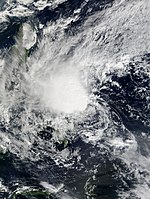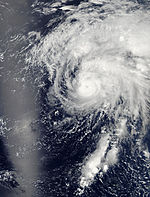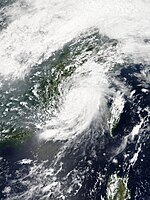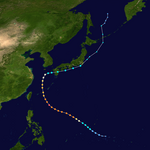2014 Pacific typhoon season
| 2014 Pacific typhoon season |
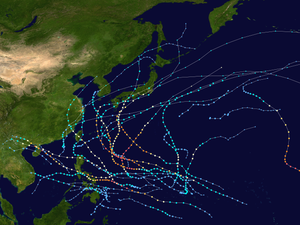
Season summary map
|
| Seasonal boundaries |
| First system formed |
January 10, 2014 |
| Last system dissipated |
January 1, 2015 |
| Strongest storm |
|
| Name |
Vongfong |
| • Maximum winds |
215 km/h (130 mph)
(10-minute sustained) |
| • Lowest pressure |
900 hPa (mbar) |
| Seasonal statistics |
| Total depressions |
33 |
| Total storms |
23 |
| Typhoons |
11 |
| Super typhoons |
8 (unofficial)
|
| Total fatalities |
538 total |
| Total damage |
$8.41 billion (2014 USD) |
| Related articles |
|
|
Pacific typhoon seasons
2012, 2013, 2014, 2015, 2016
|
| Tropical storm (JMA) |
| Tropical depression (SSHWS) |
|
|
| Duration |
January 15 – January 20 |
| Peak intensity |
65 km/h (40 mph) (10-min) 1002 hPa (mbar) |
| Tropical storm (JMA) |
| Tropical storm (SSHWS) |
|
|
| Duration |
January 29 – February 1 |
| Peak intensity |
65 km/h (40 mph) (10-min) 1000 hPa (mbar) |
| Typhoon (JMA) |
| Category 1 typhoon (SSHWS) |
|
|
| Duration |
February 27 – March 5 |
| Peak intensity |
120 km/h (75 mph) (10-min) 975 hPa (mbar) |
| Tropical depression (JMA) |
| Tropical depression (SSHWS) |
|
|
| Duration |
March 17 – March 24 |
| Peak intensity |
<55 km/h (35 mph) (10-min) 1004 hPa (mbar) |
| Tropical storm (JMA) |
| Tropical storm (SSHWS) |
|
|
| Duration |
April 2 – April 8 |
| Peak intensity |
65 km/h (40 mph) (10-min) 998 hPa (mbar) |
| Severe tropical storm (JMA) |
| Category 1 typhoon (SSHWS) |
|
|
| Duration |
April 27 – May 2 |
| Peak intensity |
95 km/h (60 mph) (10-min) 985 hPa (mbar) |
| Tropical storm (JMA) |
| Subtropical storm (SSHWS) |
|
|
| Duration |
June 9 – June 12 |
| Peak intensity |
75 km/h (45 mph) (10-min) 994 hPa (mbar) |
| Tropical storm (JMA) |
| Tropical storm (SSHWS) |
|
|
| Duration |
June 13 – June 18 |
| Peak intensity |
75 km/h (45 mph) (10-min) 996 hPa (mbar) |
| Typhoon (JMA) |
| Category 5 super typhoon (SSHWS) |
|
|
| Duration |
July 2 – July 11 |
| Peak intensity |
185 km/h (115 mph) (10-min) 930 hPa (mbar) |
The 2014 Pacific typhoon season was a slightly below average season, featuring 23 tropical storms, 11 typhoons and 8 super typhoons. The season's peak months August and September saw a very low to no activity of tropical cyclones caused by an unusually strong and a persistent suppressing phase of the Madden–Julian oscillation (MJO). The season ran throughout 2014, though most tropical cyclones typically develop between May and October. The season began with the development of Tropical Storm Lingling on January 18; and ended after Tropical Storm Jangmi which dissipated on January 1 of the next year.
The season was not as active, deadly and costly as the previous typhoon season, but was notable for producing a series of powerful super typhoons. In fact, this season saw the most number of storms reaching Category 5 intensity (seven -- Neoguri, Rammasun, Halong, Genevieve, Vongfong, Nuri, and Hagupit) in Saffir–Simpson wind scale since 1997.
The scope of this article is limited to the Pacific Ocean to the north of the equator between 100°E and 180th meridian. Within the northwestern Pacific Ocean, there are two separate agencies that assign names to tropical cyclones which can often result in a cyclone having two names. The Japan Meteorological Agency (JMA) will name a tropical cyclone should it be judged to have 10-minute sustained wind speeds of at least 65 km/h (40 mph) anywhere in the basin, whilst the Philippine Atmospheric, Geophysical and Astronomical Services Administration (PAGASA) assigns names to tropical cyclones which move into or form as a tropical depression in their area of responsibility located between 135°E and 115°E and between 5°N–25°N regardless of whether or not a tropical cyclone has already been given a name by the JMA. Tropical depressions that are monitored by the United States' Joint Typhoon Warning Center (JTWC) are given a number with a "W" suffix.
...
Wikipedia


